#Fender Esquire
Explore tagged Tumblr posts
Text

Syd Barrett w/ his Fender Esquire | 1965
68 notes
·
View notes
Text
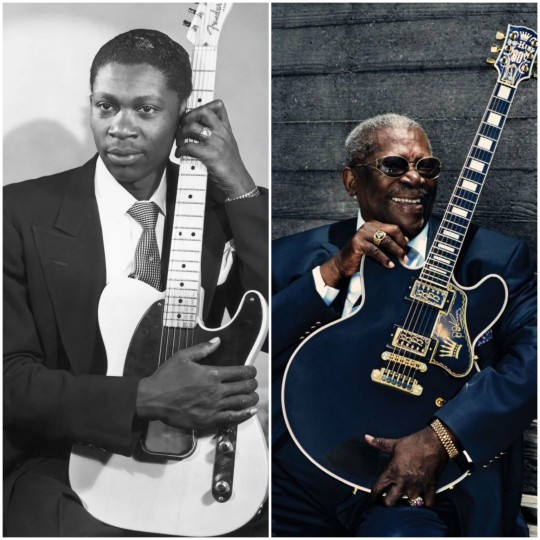
... sound of rebellion ...
Born on this day 99 years ago, the great blues and rock figure B.B. King, a guitar master with his own style. He gained the nickname "Beale Street Blues Boy", which was later shortened to "Blues Boy" and finally to B.B. King. He was a major influence on Eric Clapton and Rolling Stone magazine placed him behind only Jimi Hendrix and Duane Allman in its list of the 100 greatest guitarists of all time. I was lucky enough to enjoy his fantastic guitar play on concerts.
youtube
#b. b. king#happy heavenly birthday#sound of rebellion#famous guitars#fender esquire#fender guitars#fender#telecaster#gibson guitars#gibson es 355#lucille#music#blues#Youtube
10 notes
·
View notes
Text

Jeff Beck entertains a couple of Yarbirds fans when the band play the National Jazz And Blues Festival in Richmond, 1965.
7 notes
·
View notes
Text


Joe Strummer and his 1st May Take A Holiday Fender Esquire
25 notes
·
View notes
Photo

Crazy Little Thing Called Love
I'm a fan of the early days of rock 'n' roll, which this early eighties song really replicates. The song “Crazy Little Thing Called Love” was written by Freddie Mercury in 1979 and appeared on their 1980 album The Game. According to Freddie, the song took him “five or ten minutes” to write, using a guitar. He explained “I was restricted, knowing only a few chords. I simply had to write within a small framework.” That accounts for the simplistic 1950s feel…along with Freddie’s respect for Elvis and the pre-Beatles British rock-star Cliff Richards.
On the single, Queen guitarist Brian May wanted to emulate Rick Nelson's and Presley's longtime guitarist James Burton, and at producer Reinhold Mack’s suggestion used a Fender Esquire rather than his regular Red Special for the recording session. It’s one of the few songs where Freddie played the guitar live, check out his Live Aid performance. As Freddie said at Live Aid. This song “is dedicated to beautiful people here tonight…that means all of you.”
#Queen#freddie murcury#crazy little thing called love#classic rock#rock#music#audio#Fender#Fender Esquire
5 notes
·
View notes
Text
Hello there.

Okay, now that I have your attention, welcome to a subseries of my ramblings I'd like to call:
"X Was A Mad(wo)man"
This is a series in which I will take a look at patents, guitar, bass or drum techniques, and give my own little comments on how crazy they are. People who know me from the Curated Tumblr Discord Server (hereafter referred to as CTDS) will recognise this format from when I rambled about 12-string guitars for 2 straight hours. For everyone not from CTDS, I wish you the best of luck in trying to follow along.
So, who is our first subject? Oh, just a radio repair guy from California, you probably won't have heard of him. Who is he? One Mr. Clarence Leonidas Fender, founder of and innovator for famous companies such as Fender Musical Instruments Corporation (sold to the Columbia Broadcasting System [CBS] in 1965, rescued from CBS in 1985 by William Schultz and the company's employees), Music Man (technically a silent partner to the founders, ties cut in 1979 after issues regarding payment for refinishing), and G&L, founded by himself, Dale Hyatt and George Fullerton.
If you want to go, now would be the time. If you want to read on, buckle in, this one's going wild from the get-go.
Fender was born in August, 1909, to parents who owned a very successful orange grove between Anaheim and Fullerton, California. His childhood was presumably unremarkable, apart from when he developed a tumor in his left eye, causing said eye to be removed, and replaced with a glass one. This, you might be surprised to know, is what made him ineligible for the draft during WW2. That, however, is for later. For now, let's go back to Fender's life and times.
He was interested in piano and saxaphone during his youth, but later developed an interest in electronics, which only strengthened after a visit to his uncle's automotive-electric shop at the age of 14. Why? Because of a project his uncle had made: a radio, cobbled together from spare parts. Soon thereafter, he started repairing radios in his parents' house.
He wasn't doing this as a full career at this point, not by a long shot. If anything, it seems like it was only a hobby from the late 1920s onwards. He went through college majoring in accounting, and later did work as both an ice delivery man and a bookkeeper (alternate title for an accountant, if you didn't know; there's a reason their job is to balance the books), but his biggest job, at that point, was in the mid-1930s, when he was approached by a local bandleader to make six public address systems for Hollywood dance halls.
Now, let's pause there. What is a public address, or PA, system? According to Wikipedia, a PA system is "an electronic system comprising microphones, amplifiers, loudspeakers and related equipment." They're basically used to make people louder for the purpose of addressing many people. For the few, if any, Brits that follow me, we'd call them Tannoys because that was the main brand of them over here.
An interesting subset is one directly used for live music, called a sound reinforcement system. That's the kind where the music's fed through the mixing console, and then adjusted to be louder or quieter depending on the requirement. It's quite ingenious when you think about it. It also allows for feeding in of prerecorded sounds and backing tracks, just to allow for extra accuracy when compared to the studio version.
Back to Fender, he started Fender Radio Service in 1938 after returning to Fullerton with his wife Esther Klosky, and soon after, musicians and band leaders alike began coming to him for their PA systems, which he built, rented and sold, and the amplification for both the amplified acoustic guitars which were becoming popular in big band and jazz music, and the Hawaiian or "lap steel" guitars which were making headway in country music.
But then, the Second Small Disagreement happened. Well, I say it "happened", it had been happening for at least 3 years by the time America got involved. Anyway, during this time, due to being ineligible to fight for America due to his glass eye, Leo Fender was still in America, making these amplifiers and PA systems, and then he met Doc Kauffman. He's another inventor you might know for his work with Adolph Rickenbacher (yes, that's how you spell it as originally written, he only changed it because of his cousin Eddie.)
Kauffman and Fender, upon the urging of the latter, started a company together: K&F Manufacturing Corporation, the purpose of which, was to build amplifiers and amplified Hawaiian guitars, resulting in Fender's second patent; having previously filed a patent for his pickup design in September of that year, Kauffman and Fender filed a patent for their lap steel guitar design, and in 1945, the lap steel was sold as a kit, including a K&F lap steel amplifier.
Very early variants of the lap steel featured a metal tag with the K&F logo on it, while later versions had it stencilled on. The earliest models also have a body design difference - on the left is a 1943 K&F lap steel in possession of the Museum of Pop Culutre; on the right, a 1945 K&F lap steel.
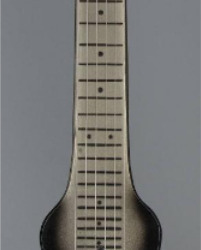
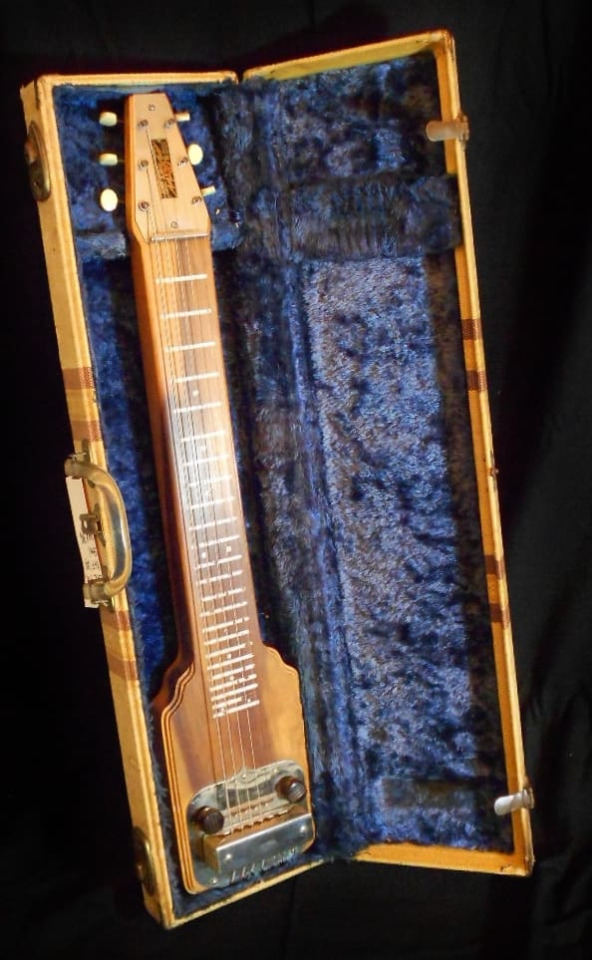
As you can see, there's just a few differences here. First of all, the body shape: the 1945 lap steel is just a slab, while the 1943 model has a slightly contoured body, akin to a violin. Secondly, the headstock: the 1943 model is exactly as the patent depicts, with a rounded rectangular headstock, similar to Martin headstocks, while the 1945 headstock has entirely straight string pull.
Now, considering the era of guitars we're talking about here, that is an actual miracle, because the main two competitors for this were Rickenbacker and Gibson. Martin and Harmony were mostly doing their own thing, and most of the other big names weren't even there. If you didn't know, or couldn't guess without it being pointed out to you, Gibson and Rickenbacker's headstocks are a bit... wacky, when it comes to having manageable string pull. The main issue is that the strings splay out to the sides in both cases...
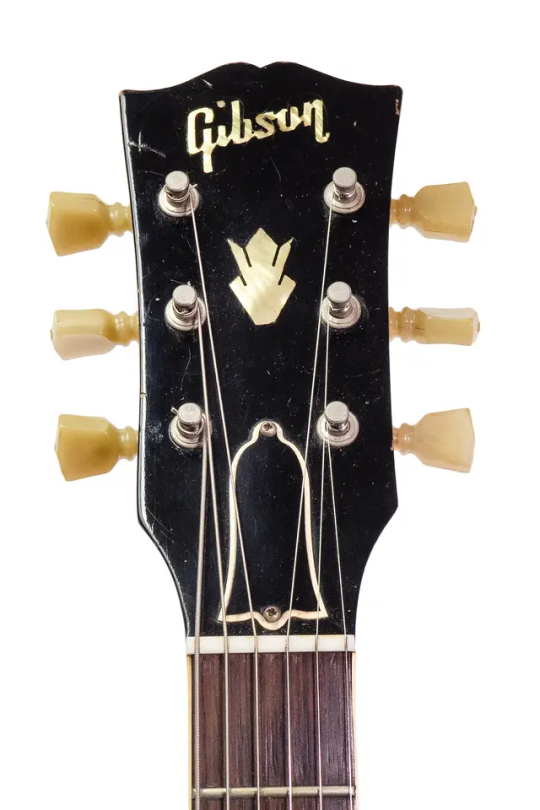
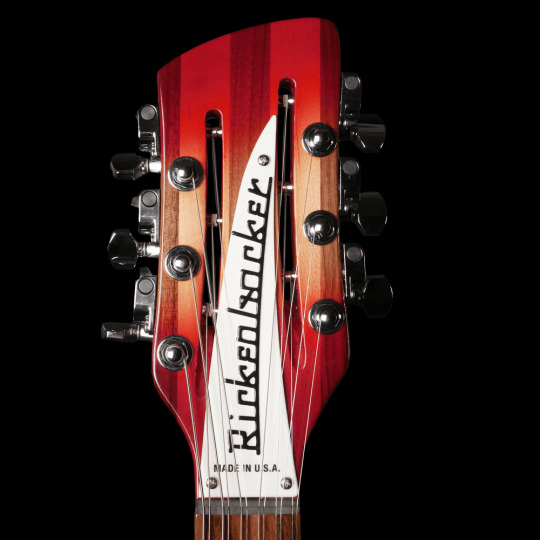
...which places emphasis on the logo of the manufacturer (as if the headstock shape didn't already do that).
Fender wasn't the only one figuring out string pull around this time, either, as Paul A. Bigsby, inventor of the Bigsby vibrola, was also working on guitars around this time. Fender and Bigsby did work together at one point, or at least they both knew each other. Bigsby was, however, an inventive soul, and interested where Rickenbacker's idea of a solid-body electric guitar would go, and so was another madman: Lester William Polfuss, known more by the stage name he recorded under, and the name chosen for his Gibson endorsement: Les Paul.
I will not touch on Les Paul even slightly in this post. Just know that he built his own neck-through semi-hollow guitar out of a 4x4 fence post, and a disassembled Gibson and Epiphone archtop each. Why? In pursuit of the cleanest tone possible. Think of it as like if metal bands tried one-upping themselves every album, making each on dirtier, more distorted, more grungy and crunchy.
There is a story of a feud from about 1949-1950, though. Bigsby built a solid body guitar for a country player, Merle Travis. The original didn't have the vibrola, and looked remarkably like a Les Paul with a Trini Lopez headstock (or an Aldo Nova Les Paul if you're into '80s rock). Fender asked to see this guitar he'd made. Then, in Spring 1950, the Esquire came out. That is to say, version two of the Esquire came out.
Yeah, the Esquire didn't look like that at first. Instead, it looked more like this...
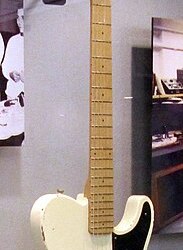
No, your eyes do not deceive you, that is a double-sided headstock on a Fender electric Spanish guitar that wasn't made of surplus 12-string parts. And yes, it only has half a pickguard, and a separated control plate. Overall, the lower half is laid out much more like the Stratocaster than the Esquire, so much so that it makes you wonder if Leo decided to revisit this control layout when it came time to do the Stratocaster design.
Now, this version of the Esquire had no truss rod in the neck, which was one massive block of maple, and had a pinewood body. The Esquire we all know is either alder or ash, rarely roasted pine, with a maple bolt-on neck fitted with either a rosewood fingerboard, or a one-piece neck made of maple with a skunk stripe to hold the truss rod in place.
Now, I've rambled for a while now about a guitar, so surely we must be ending, right? Well, for everyone aware of how big Fender is as a company, it... yeah no, this is only the beginning. Anyway, the Esquire was available in black or in a semi-transparent blond acetate lacquer, which is where the famous Butterscotch Blonde colour comes from. One thing I'd like to note before we move on: the advertisement Esquire, and the commercially released Esquires have one difference between the two: the ad model hasn't got a selector switch. This requires stepping back a couple years to explain, though.
One of the features of Fender's lap steels early on was something referred to as the "Organ Button", a circuit between the pickup and the output jack that, somewhere in there, is meant to try and simulate the sound of an organ. Now, I know what you're thinking: "What's this got to do with the lap steels? The Esquire has a selector switch!" Well, dear reader, you're correct, the Esquire does have a selector switch! However, that almost didn't happen, as can be proven by this April 1950 advert (source: Fuzzfaced):
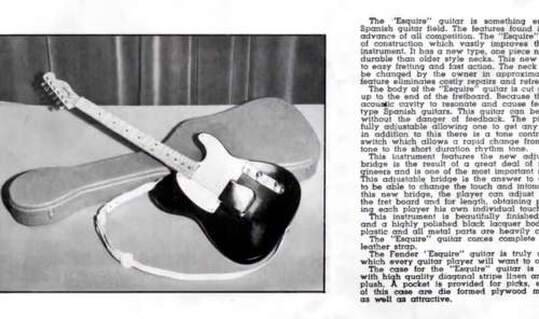
These are what's called "Lamp Button" Esquires, due to using an on/off Leviton lamp switch, designed for military use, and probably gotten as surplus. The 3-way switch it got replaced with was more straightforward, if you know how to work with your tone knob:
Back position (towards knobs): signal from pickup bypasses tone pot, meaning its as bright as it can be.
Middle position: volume and tone pots factor into output signal from pickup.
Front position (away from knobs): through some magical wizardry, as well as a 3.3kΩ resistor and two 0.05 mF capacitors, a tone that's more akin to a bass guitar makes itself apparent.
If you know the guitar order, you know where this goes. If not, let's follow the logical course:
It's 1950, and you've started mass-producing electric guitars for the general market, and everyone seems smitten with this thing for its sound, especially the front position with the filtered sound, and the Broadcaster itself is selling like hotcakes because people want the guitar with 2 pickups.
But wait, this company over in New York already uses Broadcaster for their drums! We didn't think about that! Quick, get the decals modified, we'll sort out new names for them later.
Wait a second, people like the filtered sound? It sounds like an upright bass if you lower the tuning of the bottom string... Oh, there's an idea! What if we made a bass that's more like the Esquire?
(Note: the above is purely a summary of late 1950 and 1951 for Fender, covering the success of the Esquire and Telecaster, the dropping of the Broadcaster name, leading to the highly sought-after "Nocaster" variant, and the creation of our next item.)
As a result of all this rushing about, as stated above, we got the "Nocaster" variant of the Telecaster, and the next item: the Fender Precision Bass. Like its little brother, the Telecaster, the Precision Bass is a string-through body with a bolt-on maple neck complete with the usual Fender skunk stripe. It is, of course, much longer than the Telecaster, with a full 34" scale length and much larger strings, but that's to be expected with a bass.
Original P-Basses were much like the Telecaster in design, albeit with an upper horn, and a finger rest below the strings to allow the player to strike the strings with their thumb. It also had a pickup and bridge cover, which just... existed on there; I think most players tended to toss those in the case and never use them again.
Now, who was this designed for? It can't have been for the standard bass players of the age, they still swore by their upright basses. From what I can find, it was designed for big band guitarists, with two of the biggest original users being Roy Johnson and Monk Montgomery, both of Lionel Hampton's big band. Johnson was actually the first to use this style of instrument in a concert setting, something that surprised contemporary music critic Leonard Feather, who wrote in Down Beat that this was due to hearing bass sounds from a guitar. Montgomery, however, was the one to help popularise the P-Bass, even if veteran bass players called it "a weak note amplified" or "an amplified plink-plonk".
For what it's worth? I think they were just sour that it was getting easier to play bass. I've not played an original-style P-Bass myself, but I have played the more well-known variant, and it certainly doesn't sound weak or like it's going "plink-plonk" at you. Anyway, it's the year 1952, and Fender have settled on a new name for the guitar: the Telecaster, named for this new medium getting really popular, something called "television" or something like that. It's still selling like hotcakes, but all this time, Leo's been collecting feedback from guitarists. After all, he's not just an inventor, he's an innovator; he wants to make these guitars better for people.
One thing he had heard from guitarists is that the intonation is good, but it should be individually adjustible, so they can get it sounding exact all the way up the neck, but by far the biggest critic was Bill Carson, a Western swing guitarist, who said that the next model should have "body contours" which would make it far more comfortable to play and "wear" in comparison to the plank of wood that the Telecaster was, famously remarking that it should fit the body "like a well-tailored suit."
This one was to be the Stratocaster, which entered prototyping in late 1953, with Carson helping beta-test the design. The design was slightly inspired by the dual-horn body of the P-Bass, and when it entered full production in 1954, the P-Bass was modified slightly to include slight contouring, a new two-section bridge, and a new 1-layer white pickguard, while keeping the same control layout, headstock design and general Telecaster aesthetic.
The Stratocaster, though, that became a hit almost immediately. Unlike the competition's guitars, which were either amplified acoustics or something like the Electro-Spanish or Les Paul, it didn't immediately or significantly resemble prior acoustic models, not that Fender previously made acoustic models. Their popularity was so great that, even today, Strats are some of the most recognised electric guitars out there, on par with the SG, Les Paul, Telecaster and some Rickenbacker guitars.
Now, up to this point in time, and up to 1971, with the introduction of the adjustible-tilt 3-bolt neck, all of Fender's guitars were designed with a heel-adjust truss rod in mind, meaning that before 1971, all Fender guitars had to have their neck relief set by either relieving the tension of the strings, and raising the neck high enough to access the heel adjust, or, and this seems to be how it was intended in the '50s and '60s, you take your strings off, you take the neck off, and then you adjust the truss rod, before then putting your neck back on, putting the strings back on, and then checking the relief. Yeah, not fun. I'd imagine it was changed because people were fed up of the rigamarole of doing all that.
Anyway, the other thing that the Strat had going for it is the 6-point synchronised tremolo- wait, tremolo?! Yes, tremolo; Fender quite famously mixed up tremolo (change in amplitude) and vibrato (change in pitch), which carried over to the 1956 Vibrolux amplifier. The synch trem was something else specifically requested from criticism, as the only other options available on the market at the time, the Kauffman and the Bigsby, were both separate units from the bridge, meaning that the strings would be more likely to detune from a slightly more exaggerated warble, what the Bigsby unit was intended for.
Meanwhile, the mechanism and design of the synch trem allowed for two things. First, it allowed for perfect intonation due to its six, freely moveable saddles, each with two Allen screw adjustments to follow and match the 7.25" radius of the fretboard, and second, it allowed for more exaggerated changes in pitch in comparison to both the Kauffman and Bigsby, best demonstrated by players like David Gilmour, whose control over the mechanism is, frankly, amazing.
So, we've seen 1954 come and go, but Fender never stopped. He improved the way his lap steel's tuners functioned, resulting in a classical-style tuner set, 3 or 4 on either side, facing into a hollowed-out peghead which, much like the style of peghead used on the 1945 lap steels onwards, had accurate and straight string pull.
Fender unfortunately doesn't make lap steels nowadays, but they still exist second hand, if you want to look through Reverb and similar sites for those things. Anyway, in 1956, Fender also came out with the previously mentioned Vibrolux amp, an amp that you would think acted much like a Leslie speaker. Well, no. It has an oscillator in the circuit, but audio oscillators for a guitar sounds more like a phaser to me than a Leslie. Leslies give the tonal quality that John Lennon's voice had in Tomorrow Never Knows, or the wavy guitars you can hear on Here Comes The Sun and Badge, or for my fellow prog fans out there, the B note "ping" from the piano on Echoes.
Anyway, moving on, the year is 1957, and we have some upgrades to make! Specifically, the P-Bass needs an aesthetic update, because it's still themed around the Telecaster. That needs a change, to capitalise on the success on the Stratocaster. So, they changed the pickguard, integrated the control plate into the pickguard, changed the headstock to something more like the Strat's, and put a new type of pickup in the body, leading to the quite iconic and well known split-coil. This design emphasised the D and G strings by making them brighter in comparison to the E and A strings, mainly by placing the D and G strings' pickup a whole 1.09375" (1³⁄₃��", or 27.78125mm) further away from the neck.
An inch doesn't sound like much, but when you're talking about guitars, everything is inches. Never feet, never millimetres (unless it's a European brand like Höfner), always inches. For example, something I've neglected to mention for the entire post, so far, is that the scale length of every electric guitar Fender has made so far is 25.5". That is one of the Big Three scale lengths that everyone goes for, the other two are 24.75" (actually 24.6", Gibson, you lying money-grubbing fucks) and 25", though I don't know how many people use 25" outside of PRS. There's some outliers here and there, for example 24", 22.5", which Fender used the year prior to this (1956) on the Musicmaster and Duo-Sonic, or the insanely short 20.75", but that won't become relevant until the next year on our list. Speaking of...
The year is 1958, and Fender's at it again. Last year, he prototyped using 7 pole pieces with a 6-string guitar, which I've heard makes the top and bottom string less aggressive, but I haven't investigated enough to tell if that's the case or not. But anyway, the year's rolled over and NAMM's coming up. Leo needs to figure out how to compete with Gibson this year, after they came out with the "guitars of the future". This "7-pole on a 6-string" thing isn't exactly going to turn heads, so Fender decides to bring something he and George Fullerton, a longtime associate of his, had been working on over the past year.
They decide to bring the Jazzmaster, Fender's attempt to get the jazz players on board with his guitars. The Jazzmaster is a masterclass of guitar design, specifically because it comes straight out of left field. The biggest point is that the body is offset. Now, what does "offset" mean in this context? Offsets, when mentioned in guitar terms, are a style of body with a waist which dips in at 2 separated points, like the example in this image, courtesy of ATB Guitars:
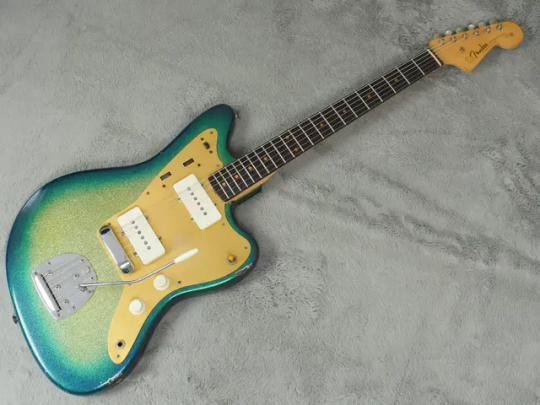
Yes, this is a real example of a Jazzmaster from 1958. Gold-guards are rare, but this is unique beyond belief. Custom colours had only just been offered, and the sparkles were aluminium flake that was mixed into the lacquer. Now, what does that signify? It signifies the beginning of the car colours. Your Surf Greens, your Candy Apple Reds, all sorts of stuff. Why? Because Fender's first factory was just down the road from an automotive place, and why not take advantage of that?
So, the Jazzmaster gets revealed in 1958 at NAMM, and is marketed as the step above the Strat. Yes, the step above. A premium model, marketed as a solid body alternative to the standard jazz guitars that players of that genre used. He tried this, attempting to get them onto Fender's side, at the expense of Gibson, the same company who's been giving this genre's players instruments since they've been making electrified guitars.
As you can probably guess, this failed. However, an interesting thing about this, Fender actually patented the offset body design. Yes, seriously. And, because of its different ergonomics and entirely unique body design at this point, the patent was actually granted. Again, seriously. Don't believe me? Look at this:
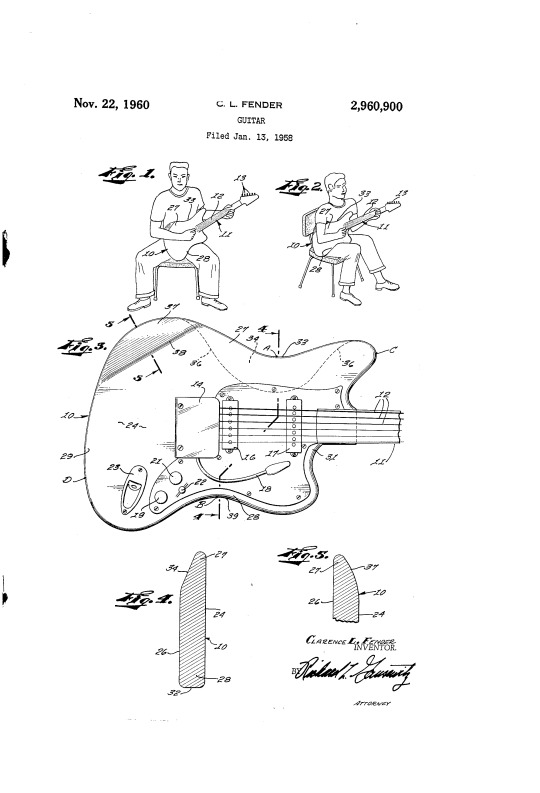
Interestingly enough, that's actually not the design of the Jazzmaster that ended up being used in any way. It never had any top-mounted output jack, and the 7-pole pickup never got used. Moreover, there's no blade switch on the Jazzmaster, and the patent is entirely missing the rhythm-lead circuit, which is an entirely different kettle of fish. The tremolo and bridge is entirely different to the release, and the thing is, that's because this uses the original design of the Jazzmaster!
Strap in even further, because HOO BOY THIS GETS WEIRD.
So, this is a photo from 1957:

The composition of this picture is actually incredible for Fender history. I can't credit myself with having discovered it, though. From what I can find, this was actually a photo taken in Leo's office. With context and external knowledge, I can say with some certainty that this was taken between 1957 and 1958, and features some very interesting variants of guitars.
For one, that third guitar? That's an electric mandolin. Never heard of them? Makes sense. They are rarely ever made, and most, if not all, mandolin players prefer double-course acoustic mandolins like those produced by Gibson. The one seen in the image has a Telecaster-style pickup, a 24 fret neck (wow, who would have thought that there'd be a 24-fret Fender in the 1950s that could be played without a slide?), and an ash body, contrasting the guitar it's next to, the Strat. Strats, by 1956, had been moved to alder bodies from ash because of cost reasons; alder was both more affordable and more readily available than ash was.
But that's not the really crazy thing about this photo. The crazy thing here is the leftmost guitar on display, being the style of Jazzmaster featured in the original patent, complete with 7-pole pickups, a bar that's far more curved than anything the Jazzmaster later got, and the original style of pickguard. It even has the output jack mounted like a Strat, as it was originally. Another thing of note is the Telecaster with Wide Range single coils, or to use their proper name, JM soapbar coils.
Just kidding, no one knows what the fuck to call them! They're about the size of a Wide Range humbucker, but those didn't come into use until 1971 along with the head-adjust truss rod. Fender, the company, has made modified designs of the original pickup that actually are a Wide Range humbucker, just put underneath a modified version of the JM pickup casing. So you know what? Personal opinion time, these are called Wide Range single coils, due to the fact that it's basically what they are. The pickup is wound wide and hot for greater articulation, just like Wide Range humbuckers.
So, what about the Strat? Anything special there? Not really, no. If anything, that's the most normal guitar there, and the only thing I can think of that's of any interest is that the thing's a solid colour. Not a surprise, considering that they had started doing solid-colour finishes at this point, starting off with stuff like Surf Green and Fiesta Red, what the boys called "Fullerton Red", after ol' Georgey-boy, who I mentioned earlier. He'll come back in later.
Also of note in this year, and something especially incredible, at least from Fender: the first solid-body electric violin. Yes, seriously, Fender made electric violins in the late 1950s. They also got reissued later down the line, but that's not until the late '60s, and we've got at least 10 years to get through before we're there.
Now, we're on 1959. Fender's got a patent on a new pedal steel design, which he's still making and doing very well with at this point, and the Jazzmaster has finally entered full-scale production. Does it live up to its name? Does it actually master the jazz market and bring Fender some jazz musicians? Quite simply, no. It doesn't even come close. Why? Well, one thing you need to know about guitarists and musicians is that we are creatures of habit and tradition. Most will go with known factors over unknowns, and Fender just threw all of that out of the window and said to the jazz players, "Here, try this! I promise it won't suck!", all while trying to not look like the cat that crapped on the carpet.
However, Fender lived in southern California, just southeast of Los Angeles. What comes to mind when you think of late '50s, early '60s Cali? Surfing. Yeah, that's right, kick up Misirlou, DIck Dale's here. ...Okay, so maybe not Misirlou, that was released 1962, and we've only just reached 1960. But anyway, Dick Dale was enlisted by Fender himself to test new equipment coming out of the factory from Fender's brain, up to the point where Fender had stated in interviews, "When it can withstand the barrage of punishment from Dick Dale, then it is fit for human consumption."
That quote was about an amplifier, of all things. The reason is that Dale liked to play loud. Not just loud, but loud, like "hear yourself playing over the screaming crowd" loud, to the point where he would regularly break amps by overloading them consistently. Fender then went with Freddie Tavarez, who had previously helped him prototype out the Stratocaster, to the James B. Lansing speaker company to ask for a custom 15" speaker, leading to the JBL D130F, the speaker that was then used in the Fender Showman amp, the first amp that Dale could not explode through the power of high-volume surf rock.
Fender also released a new electric bass unto the world in 1960 - the J-Bass, or Jazz Bass. Like the Jazzmaster, it was envisioned to worm its way into the jazz scene and uproot the traditional. Interestingly enough, though it didn't do as intended, it worked nonetheless, and Jazz Basses are one of the more used basses out there, compared to Gibson's offerings that seem to be hen's teeth by comparison, or Rickenbacker's which have their place, but are usually relegated to use by players wishing to emulate the sounds of Geddy Lee, Macca, Lemmy or the late, great Chris Squire.
The J-Bass, meanwhile, seems to have been used by everyone and their mums, offering some of the most versatile tones imaginable. John Entwistle recorded the bass solo of My Generation using a Jazz Bass strung with LaBella nylon tapewound strings, rather than the roundwound thin strings that came stock on Danelectro Longhorn basses at the time (and weren't available separately). Depending on the source, Entwistle may have played using a pick, or he may have used 3-finger technique, who the fuck knows. Hell, considering when the song was produced (1965), it may have been Betsy, the Jazz Bass now owned by Guy Pratt.
That's far and away past our current range, but something I'd like to mention - a lot of this has been jumping around the timeline, which is something I quite like to do with these posts. After all, what's the fun in talking about your hyperfixations and sticking to a rigid timeline? So anyway, back to 1960. The Jazz Bass was originally produced with stacked volume and tone knobs, probably the earliest recorded use of dual-gang or "stacked" potentiometers in commercial guitars. They got phased out in 1962, though, so any vintage J-Bass with said stacked pots are worth tens of thousands of your choice of currency.
This isn't even me talking out of my ass. Thanks to one guy in Emeryville, California selling one on Reverb, I can show you:
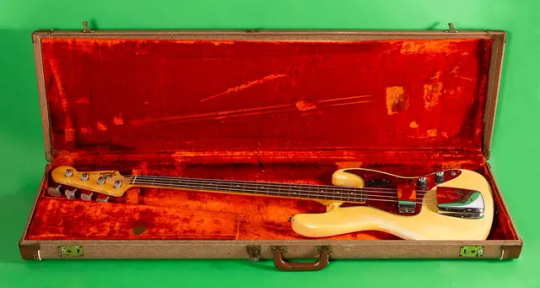
Now, okay, it's not that good a photo. But look at the knobs. See how there's only two? And not only that, see how there's skirting around the bottom? That's the stacked pots in action. I don't know which level does which, because I've not actually had experience with this specific style of J-Bass, only the later style with individual volumes and a master tone. Presumably, though, the knurled part is the volume, and the skirt is the tone.
You may also notice that there's covers over the pickup and the bridge. That's not just something on the J-Basses from 1960-1961. This is something Fender did for every guitar he made until a model later down the line. Every guitar that Fender made from 1943 up until around 1964, all of them had pickup covers, sometimes referred to as "ashtray" covers, which makes sense considering how prevalent smoking was in this era.
Moving on, the year is now 1962- *record scratch sfx*
Wait a second - why are we skipping 1961?
Because no guitars got released in 1961. Some patents got applied for in 1961, but neither were approved until a few years later, so they aren't of relevance.
But something did get released in 1961! The Bass VI!
I assure you, I did not intend to miss this out. I'm writing this bit when I'm partway through the point when Fender sold the company to CBS; everything after this was written before this specific bit is. I forgot about the Bass VI until now. If you couldn't tell by this point, I'm scatterbrained as fuck. So, let's quickly rectify things.
The Bass VI was released in 1961, and it was niche at best. Originally, it was styled like a Jazzmaster in terms of design and controls, but in 1963, it got an aesthetics update to bring it in line with the Jaguar instead. Originally, it looked like this (image credit: RetroFret):
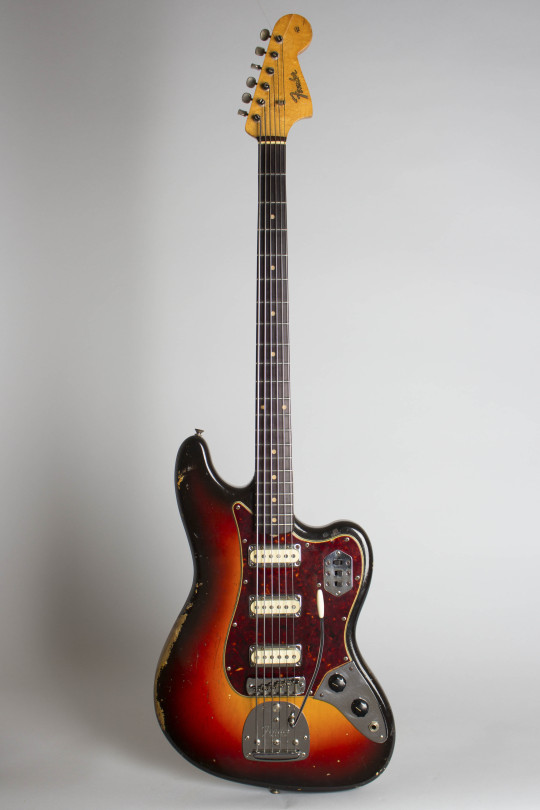
That's unique-to-the-instrument pickups, master volume and tone (using the Jazz Bass' later style of knob), only 3 pickup switches instead of the 4 it'd later be, and no headstock decal. Meanwhile, the rework looks more like this:
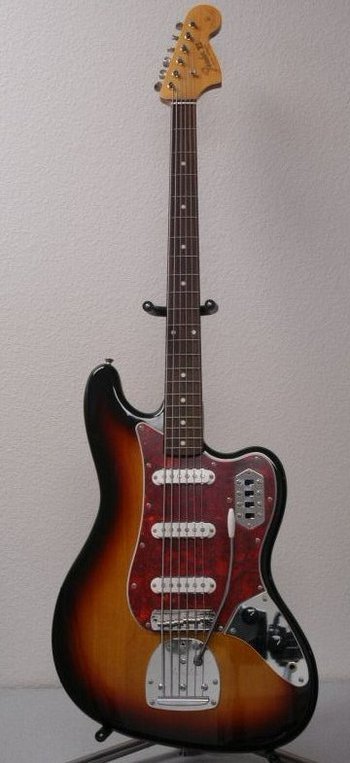
4 switches, Jag-style pickups, and everything else basically the same. Interestingly enough, this is one of two 6-string basses Fender has on offer nowadays. The other is a Squier offering that's a little more contrabass than this.
Now that that's sorted, back to your regularly scheduled timeline-hopping. *reverse record scratch sfx*
I did miss out some student models from the list, like the Duo-Sonic and the Musicmaster, both released in 1956. Both looked much like something we'll get to later, but make no mistake when you look them up - they are both normally bouted, neither have an offset waist.
But anyway, 1962. The Jazzmaster is... sustaining, but it's not exactly popular with the intended market. Jazz players really like those jazz guitars, don't they? "But Dale and his contemporaries like it," goes Fender's thought process, "why don't we try appealing to them?" And thus, prototyping begins for this brilliant thing to release in '62:
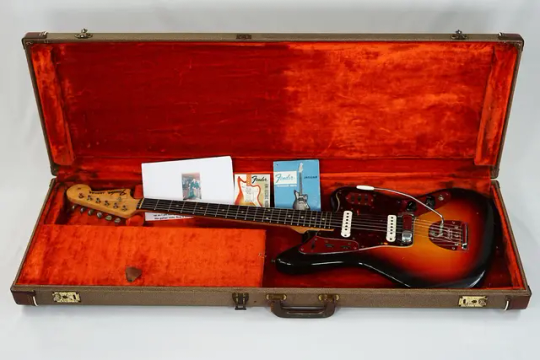
This is the Fender Jaguar, and it was entirely aimed at surf music players in the ads. It's not like that was the original intent; the Jaguar was marketed at the same tier as the Jazzmaster, the top-of-the-line feature-laden tier that was meant to draw people to Fender and away from Gibson.
Now, I've played a Jaguar before, and I speak from experience when I say, they are cool as shit. There is one massive issue, though, and that's the fact that they do not like being set up properly. They'll stay set up properly, but they will give you the greatest grab-bag of grief you've ever experienced in the process of setting a guitar up. There's also a few nitpicks I had with it, but those are mainly from not knowing how a Jag's circuitry works. Coming from blade switches, I had no idea how the fuck this thing worked, which way the switch had to be for "on", and which it had to be for "off". Other than that, though, I had the time of my fucking life playing that thing.
But anyway, this peaked surf music player's interest massively. It wasn't as popular as the Strat or Tele, but it definitely still had its day. The ads featured beach theming, but it didn't get publicised much by surf rockers outside of the odd appearance of Carl Wilson in one of the early publicity photos. In essence, it was a guitar that the target audience enjoyed, but didn't try and promote. It didn't survive the '70s CBS era, though, even with the introduction of custom colours, block inlays, bound neck, and all that, it just didn't get popular enough, and it got axed from production in 1975.
It got better, though, don't worry.
Also of note in 1962, the
Anyway, 1963... last year of the old Musicmaster... Brian May's started on the Red Special... Nope, can't think of anything big. Let's check the patents... Ooh! Electric piano...
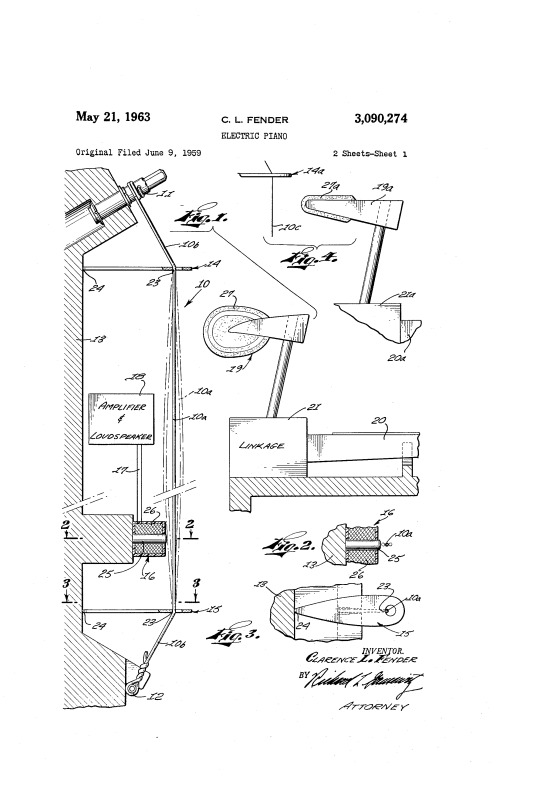
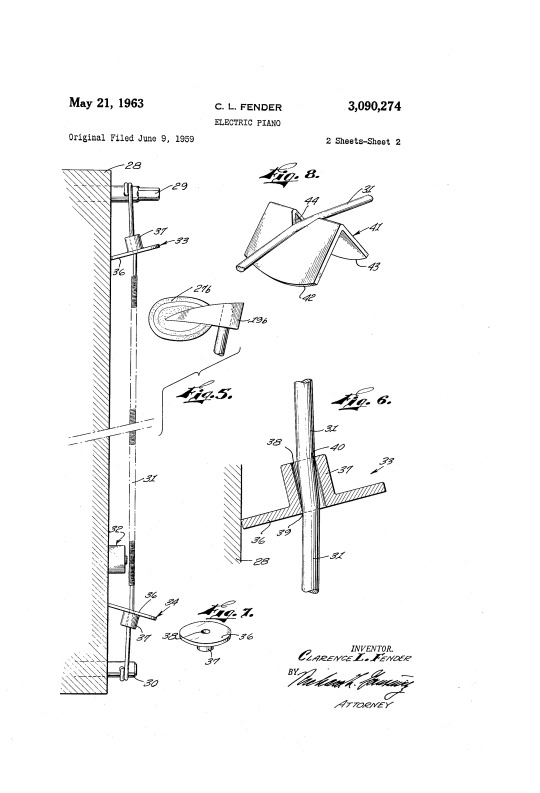
Hmm, I wonder what these are about, as if I didn't know. Yep, this is about the Rhodes, the counterpart to the other famous electric piano, the Wurlitzer. This is a tine piano, while the Wurlitzer is a reed piano. But, we're on about guitars here, so piano's out of the wheelhouse. This'll stay out of the tags, I'm too much of a guitar player to know stuff about the Rhodes and Wurli, even if they operate like how electro-acoustic guitars do nowadays.
Also in 1963, Fender's "broom handle" bracing method had its patent applied for, but that wouldn't be published until 1967, so that's not of importance here.
Moving on, we reach 1964, FINALLY. This is when a very interesting model of guitar was released: the Fender Mustang, which looked quite like this:
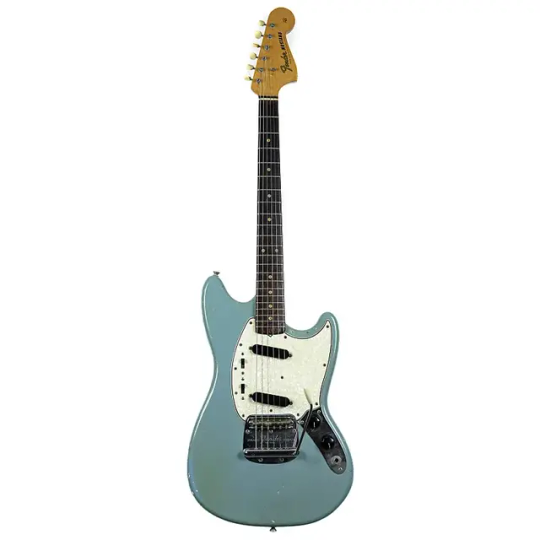
Now, there's one really famous name associated with this guitar, a Seattle-based player sadly no longer with us. Kurt Cobain didn't use a pre-CBS Mustang. No, he used a 1969 Competition Blue Mustang, with matching headstock, in a quite famous left-handed configuration. And yes, he actually was left-handed. It's "common knowledge" that he was right-handed and learned lefty, but no, he was always left-handed, but he was forced to learn to write right-handed, because '70s America is as '70s America does.
Anyway, the Mustang lead to more things: the Musicmaster and Duo-Sonic models both got redesigns using the Mustang's neck and body. "But wait! How does that work? Did they not have shorter scale lengths?" Well, yes they did. You see, the Mustang had 2 sub-variants when it released: a 24" scale length, and a 22.5" scale length. These were produced at the same time as each other, with both being offered in the short scale or the shorter scale. As such, the Duo-Sonic II and Musicmaster II (named with a II to distinguish them from the original, non-offset models) were produced from 1964 until 1969, at which point, they were axed from production, in favour of the Bronco and more deluxe version of the Mustang... is what I would say, if the Musicmaster hadn't lasted until 1982. See, the crazy thing is that these were made from surplus materials. Surplus gets added to constantly. That means they went on for as long as they could, using whatever they had left. We'll get onto that after we talk about Fender selling his company to CBS.
So anyway, we're still in 1964, and Fender's approached by a guy named Porky. No, he's not a pig, his actual name is Quilla Freeman. He'd done his own bit of tinkering with his guitar, and he wanted to present an idea to Fender. A four-pickup guitar with minimal interference between each pickup, and with each pickup actually sunken into the body of the guitar, and hidden by the pickguard. This is what would later become known as the Fender Marauder, specifically the Type I. Freeman and Quilla developed some interesting ideas about this, and Fender even put in a patent application for his design for the hidden pickups around this time:
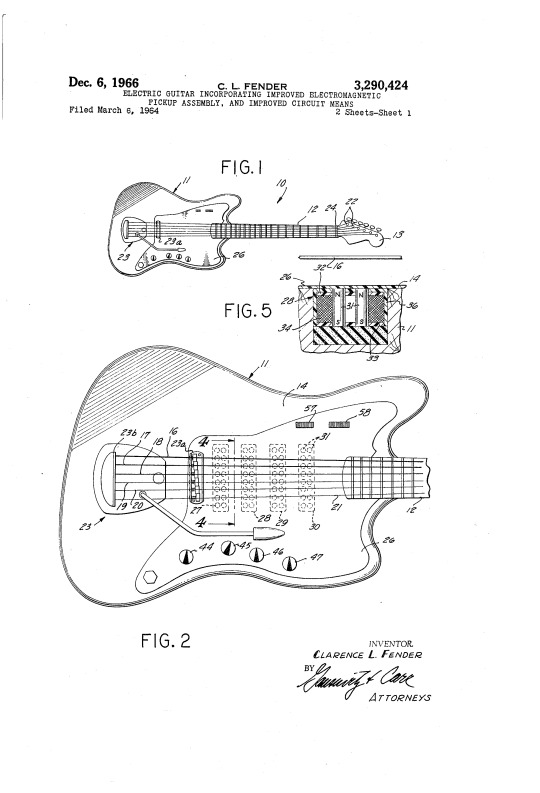
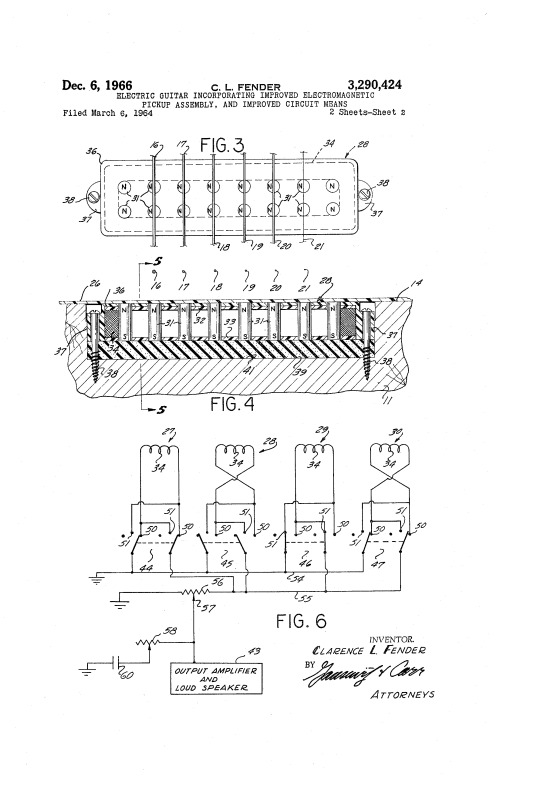
Once again, your eyes do not deceive you, that is 16 individual pole pieces. Per pickup. That's 64 total pole pieces. Also of interest is that the patent features 4 knobs, presumably rotary switches to turn each pickup off, on, or out-of-phase, the thumbwheels from the rhythm circuit functioning as master volume/tone controls, and a Jazzmaster/Jaguar tremolo. It's not as if Fender's options for tremolo systems are limited, at this point in time, he's the only one making good reliable ones, but this is especially interesting.
Now, as you can probably expect, this guitar is shrouded in so many layers of mystery, it may as well be impossible to figure it out. It's also not known why Fender's company bailed on the project, because yeah, that happened. As such, it's all a massive mystery as to why there was no official production-model Fender Marauder until 2010, of which I've made my feelings very clear.
Now you see why I want to build one.
Anyway, 1965 has finally arrived, and the Beatles are playing Strats on Help!, to absolutely no one's surprise. In January, Fender officially sold his company to CBS, and signed his 10-year non-compete clause that prevented him from working for another guitar company until 1976. But we don't care about the bureaucracy of CBS. What we're here for is the guitars, and Fender's insane madness. For example, Fender's appearance in the 12-string business. Rickenbacker had only just entered the genre 2 years earlier, and had quite famously gotten George and John on board, giving them a 360/12 and a 325/12 respectively. But CBS!Fender wanted onto that gravy train.
So Leo's still working for the company at this point, as far as I can tell. He was certainly still a consultant on board at the company, and thusly, anything he came up with became something to try out. Two examples I want to give, both very interesting, are the Bass V and the Electric XII. Let's start with the latter first because that's the most interesting. This also allows me to talk about 2 patents that I've otherwise left alone, mainly because they were filed in 1961, and they only really apply to this guitar.
The Electric XII, as the name implies, is a 12 string guitar. In 1965/66, there were only 18 guitar models, total, that were electric 12 strings being sold, brand new. How do I know this? I spent 2 straight hours in the early morning of February 1st trawling through US patents and vintage guitar catalogs that had been scanned and digitised, and I came up with this list organised by brand:
Fender: Electric XII, Coronado XII
Gibson: ES-335-12, Firebird V-12, EDS-1275
Rickenbacker: 360/12, 366/12 (I know the 370s existed, but they are not distinct enough to be separate models here)
Gretsch: 6075, 6076
Epiphone: Riviera 12, Wilshire 12
Guild: Starfire SF-XII
Vox: Bouzouki, Phantom XII, Tempest XII
Goya: 1209
Hagstrom: F12-S
Danelectro: Bellzouki
Now, the majority of these guitars were just conversions or modifications of previously existing guitars. The only one that may not have been, but I'm not sure enough on, is the Bellzouki, but the one I can absolutely tell you for a fact was not in the slightest a modified guitar is the Electric XII. The Coronado XII is actually a variant of the general Coronado model, which had 3 styles: the I, II and XII. The Coronado's not relevant right now, the Electric XII is.
The Electric XII was purposely built and designed by Fender to capitalise on the folk rock movement of the mid-to-late 1960s, with it being aimed at bands like the Byrds... whose guitarist was Jim McGuinn, an avid user of Rickenbackers, to the point where he still uses them to this day. Seriously. He even owns a ridiculously rare Rickenbacker 331/12LS (one of two known to even exist, which is wild, considering this is what the other was listed for back in 2016; they should probably, and probably do, go for more), a guitar for which no photo currently exists, thus I cannot confirm its existence. McGuinn, however, can be best and most easily seen in this cover of Eight Miles High he published 1 year ago (as of writing this) playing a 341/12LS. This is something I had never heard of, so this is brand new information to me. But this isn't about the 341/12LS, or the 331/12LS, this is about the Electric XII.
So, did it have Fender's desired impact? Did it work? It may surprise you to hear this, considering how Fender's not exactly garnered much in the way of support for the unconventional designs he's made up to this point, but it worked! Gene Clark (of the Byrds, the very same band whose lead guitarist famously exclusively used a Rickenbacker) was seen using an Electric XII in a televised appearance in May 1965, and even long after its discontinuation, Tom Petty, famous for using a 620/12, used the thing for the first leg of the 2006 NA tour he embarked on. Arguably the most interesting and famous users, however, are Pete Townshend, Eric Clapton, and Jimmy Page, all 3 household names even outside the realm of guitar.
Alas, its success was not to last, and it was put to ground in 1969, with surplus bodies and necks being reused for a different guitar: the Fender Maverick, otherwise know as the "Fender Custom", entirely different to the Fender Custom Shop that would come much later. These were 6-string guitars, as opposed to 12, and look... kinda weird? I don't know what to think of them, I'll let you, the reader, decide for yourself:
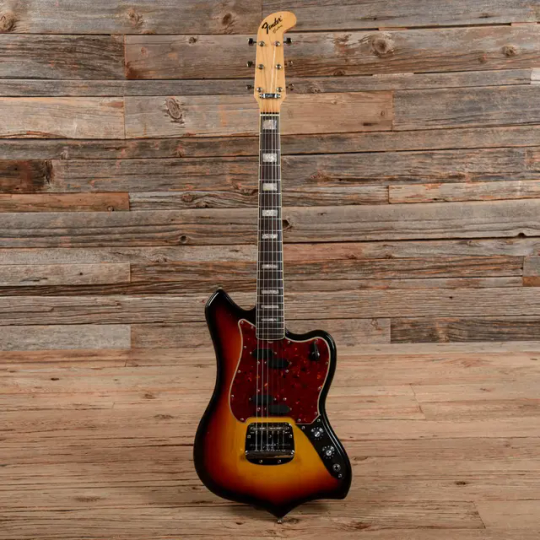
...okay yeah, nah, I'm decided now, they look fucking wrong. That neck looks wrong without 12 strings or tuners on it; the whole point of the hockey stick was to allow for more tuners without elongating the headstock, or incorporating planetary tuners. And the body, God, the body. It looks lopsided. It's had a chunk taken out of the bottom bit by the output jack, the bridge is just slightly too far from the pickguard, the upper horn's too short and got cut off. By comparison, here's what the XII looked like (note: not all the units produced had matching headstocks; this one just got real damn lucky):
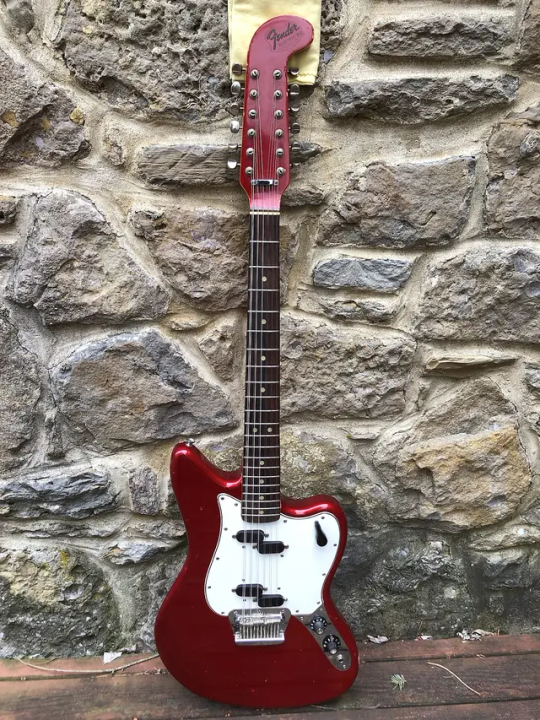
This is far better in my opinion. Anyway, remember how I mentioned the Coronado earlier? Yeah, it's relevant now.
So, the Coronado. It's not the most well known of Fender's designs. Hell, it's not the craziest either. But, it's interesting. Fender didn't have a semi-hollow or fully hollow offering up to this point; prior to 1966, there was no such thing as a "Fender semi-hollow", and frankly, it's not a surprise - they're hard things to make! But, along came Mr. Roger Rossmeisl, a name known far and away for the other California-based company, Rickenbacker.
Rossmeisl probably thought his talents would go to waste at the company. But, Fender proved otherwise, as they put him to work straight away, trying to capitalise on the high-profile usage of hollow-bodied electrics (the Epiphone Casino) by big bands such as the Beatles, the Rolling Stones, and the Kinks. It came in the aforementioned 3 variants: I, II and XII. The I featured a singular neck pickup, the appropriate amount of controls, and no vibrato unit as standard, but could be ordered with a vibrato if one was wanted. Interestingly enough, unlike the Casino, it featured a more traditional floating bridge on both units, as opposed to a fixed bridge such as an ABR-1, which, if anything, makes it more like the 1983 NAMM Crest that I mentioned in the Ideas Archive post. Here's the Coronado I, with and without vibrato, if you wanted to see it without having to trawl through all of Google's search results:
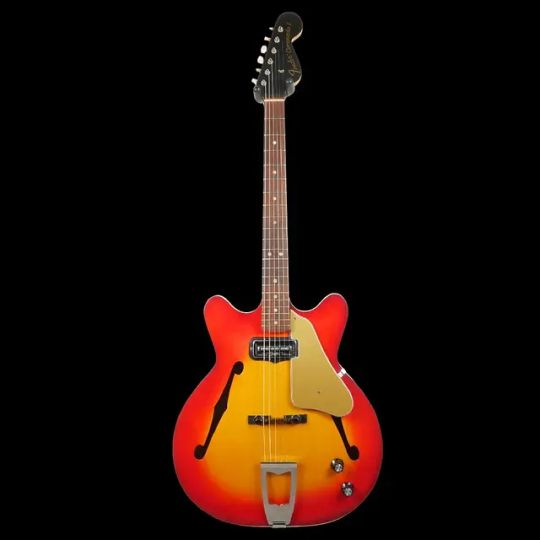
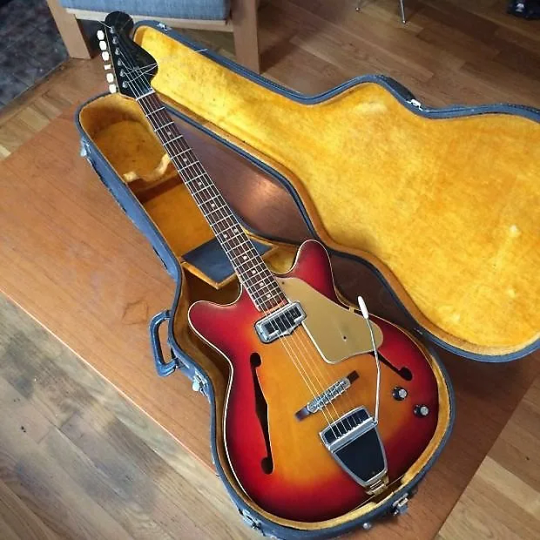
Now, the Coronado II, on the other hand, is the "premium" or, to use a Gibson term, "deluxe" version of the Coronado. If you're confused about that, let me do a quick summary: deluxe just means 2 pickups. That's what the D stands for in something like ES-175D. If there's a T, that's thinline. In short, E230-TD, the Casino's internal model number, stands for Epiphone Casino Thinline Deluxe. While this implies the existence of a large-bodied Casino, don't get your hopes up, a large-body Casino does not exist. Believe me, I've looked for one before, they do not exist.
Anyway, back to the CII. The Coronado II is the premium version for a reason: it has 2 pickups, both DeArmond-made single coils (DeArmond is the company that made the DynaSonic for Gretsch back in the 1940s), and it features that vibrato unit I mentioned earlier, which according to the patent, functions like a Bigsby mixed with the Mustang's trem system. It doesn't appear to have been a stock feature, but rather an extra, as can be attested to by these photos of vintage versions (credits: TheGuitarStore and RetroFret... again):
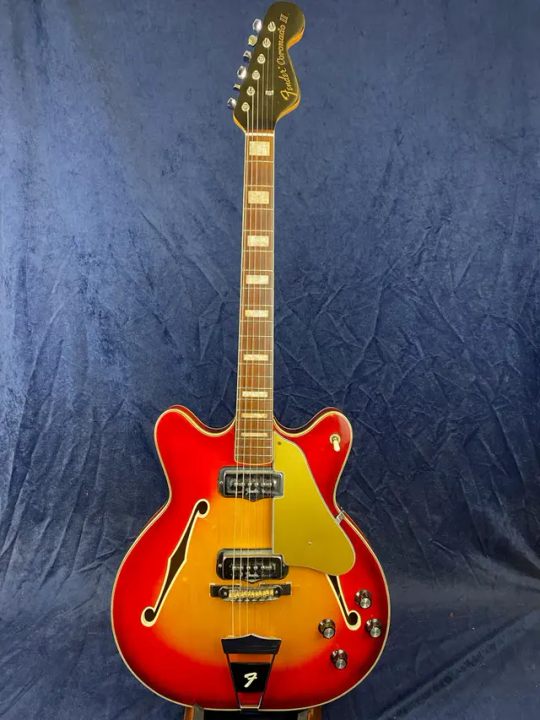
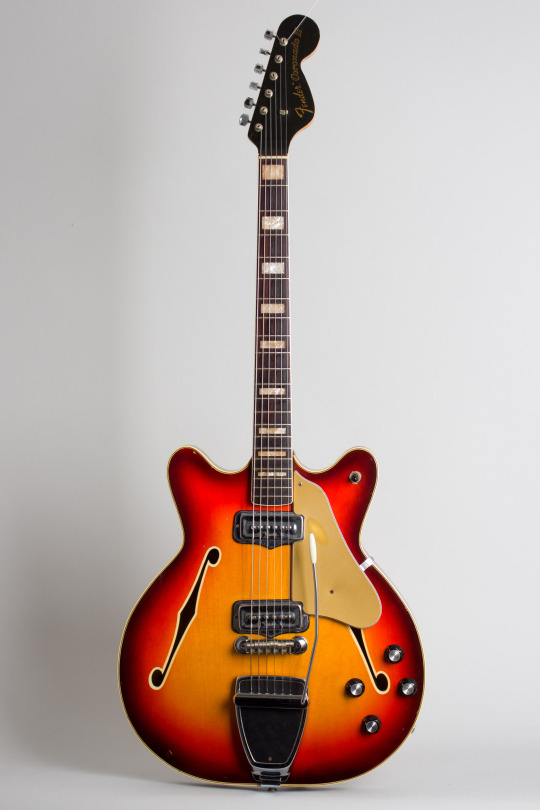
Interestingly enough, these do actually have some design variation between them! On the one with the fixed tailpiece, the bridge is left floating, and thus acts as a standard jazz guitar's bridge would. Meanwhile, the one with the vibrato has a top-mounted fixed bridge, more akin to the Epiphone Casino, but has a longer, bolt-on neck, making the guitar more of a mix between the Casino and its big brother, the ES-330.
The lower horn toggle switch will also come back later, on a favourite model of mine. You'll see. But first, the Coronado XII. This one is interesting, as, like previously mentioned, this was one of 18 models of electric 12 string on offer in the mid-to-late 1960s. It's also, as far as I can tell, the only one that's entirely a hollow body; the only one I haven't got a fully conclusive answer on is the Goya 1209, and that's because it's a Goya, they're kinda weird. It's kinda like Teisco Guitars, because those were happening at this point.
Back to the Coronado XII, the fact that it's a fully hollow body tells me something so incredibly interesting: you could, in theory, get some Lennon-style feedback on this 12 string, if you used it correctly. I wouldn't recommend it though, 12 strings like to continue feeding back once they've started. Anyway, here's what a Coronado XII looks like, with the bonus of a very figured top:
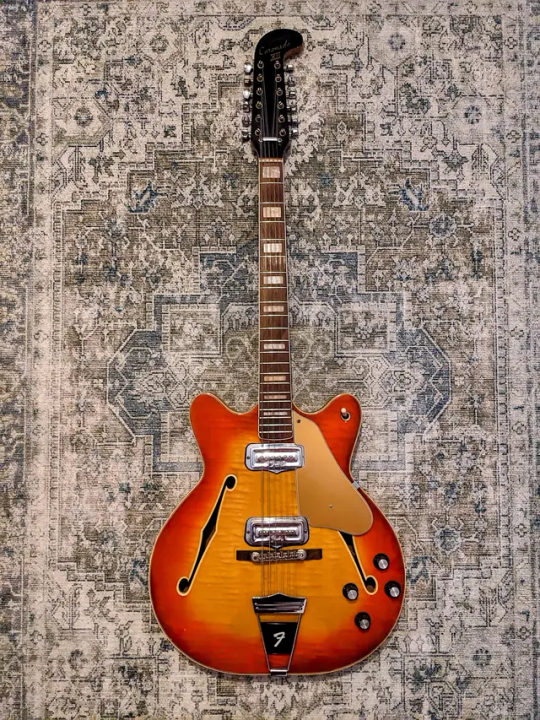
Yes, the headstock is the same as the Electric XII's, it's colloquially known as the "hockey stick", due to the bend at the very top of it looking like the head of a hockey stick. This nickname was actually acknowledged in the descripion of the Squier Jazzmaster XII on Fender's website, but its design comes back all the way to here. More modern Fender XII's will have a curved over upper part, but no hockey stick head.
Anyway, we're finally at 1967. Although the Coronado XII technically existed in 1966, it entered full production in 1967, and ran until 1972. It's actually one of the few things Fender has done that Gibson hasn't up to this point, and even now: a 12-string hollow-body electric. Both sides have done things the other hasn't, actually, because Fender haven't ever done a semi-hollow 12, like how Gibson hasn't done a fully-hollow 12. Who knows, maybe that'll change.
Back on topic, for the next 3 years, nothing of note happens in terms of Fender guitars. The big CBS headstock got introduced and used on some models, but in terms of actual models, none really reared their heads until 1969. Remember Rossmeisl? Yeah, he's still at Fender at this point, and he's now been tasked with making something... a little special. You see, back in the summer, Fender signed a deal (represented by Don Randall, the marketing genius who named the Strat, Tele and Esquire) with Apple Corps., to send the Fab Four a load of brand new Fender equipment.
Now, the late '60s saw 3 models, all brand new, come out for the world to enjoy. Only one still sees regular production to this day: the Telecaster Thinline. The other two are very difficult to explain. You see, Rossmeisl and Philip Kubicki, Rossmeisl's apprentice and later a maker of boutique basses in the US, were charged with making 2 new models of guitar: one was to be sold as regular, with a few prototypes sent out to artists, plus one kept for historical purposes, and for the other, only two would ever exist from the original production, both being the prototypes. These were the Rosewood Telecaster, and Rosewood Stratocaster.
The Rosewood Tele and Strat both started their production cycles in 1968, and before you ask, no, that's not just "rosewood fretboard" or "rosewood neck", like you can get in the Mod Shop. No, it's an entirely rosewood guitar, 2 entire slabs for the body just to make it thick enough. And fuck me, the history on these things are wild. There were 2 prototypes made for each, as stated above - one would go to an artist who definitely used Fender guitars, and one would stay as a prototype for display, so as to say "We made this real!"
The Rosewood Tele made its way into the hands of George Harrison, who used it extensively for the Get Back Sessions, which would later become Let It Be, while the Rosewood Strat was intended for the hands of Jimi Hendrix. The issue with the Rosewood Strat is that the rosewood they used for it turned out to be far too oily to work with; not in a prohibitive way, merely that it had quite a higher-than-average concentration of oil in the wood, which mean that, by the time it was ready, Hendrix had sadly passed away.
Harrison didn't keep his for long, either, giving it quite hastily away to Delaney Bramlett in the 1970s. It stayed in Bramlett's possession until 2003, at which point it was bought back by Olivia, George's widow, during an auction for $434,750, a figure which, when adjusted for inflation, is now $745,437.94. For my fellow Brits out there, that's a figure of £270,936.20, which becomes £536,847.76 in today's money. In short, much moneys were spent on this guitar!
The Rosewood Strat prototype not intended for Hendrix was much maligned as well, as its location is entirely unknown; not even Fender has it! The Rosewood Tele prototype seems to still exist, though I may have been wrong about the "plus one for historical purposes". I'm not going to sugarcoat that bit, sometimes I get stuff flat-out wrong, and if I'm too esconced in a point, I can't just, y'know, go back and change it without writing something new, and it's all this massive kerfuffle that I despise and tend to avoid.
So, to avoid exactly that, and more issues on top, let's just get visuals out of the way. 1 Rosewood Strat, and 3 Rosewood Teles - the top right is the 2022 reissue of the Tele that George got (differentiated from production by a chambered body and an Om symbol on the neck plate), the bottom left is the Tele that Elvis got, and the bottom right is a production model from 1969, courtesy of ATBGuitars:
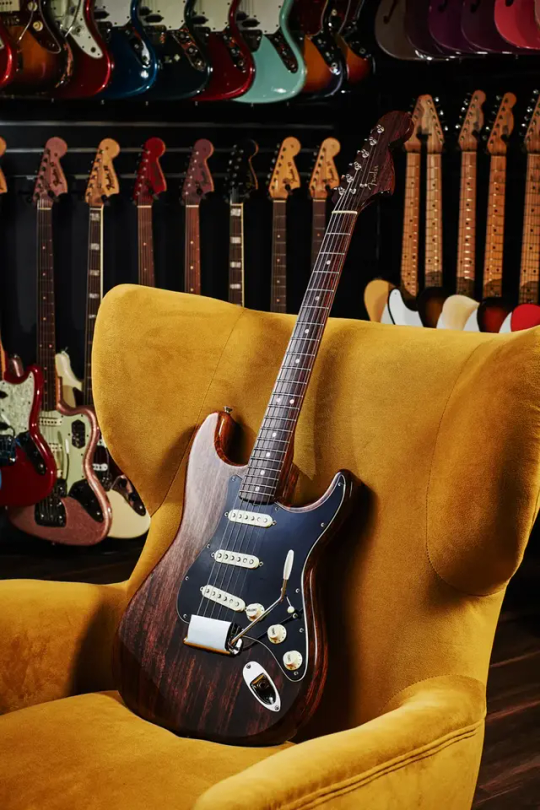
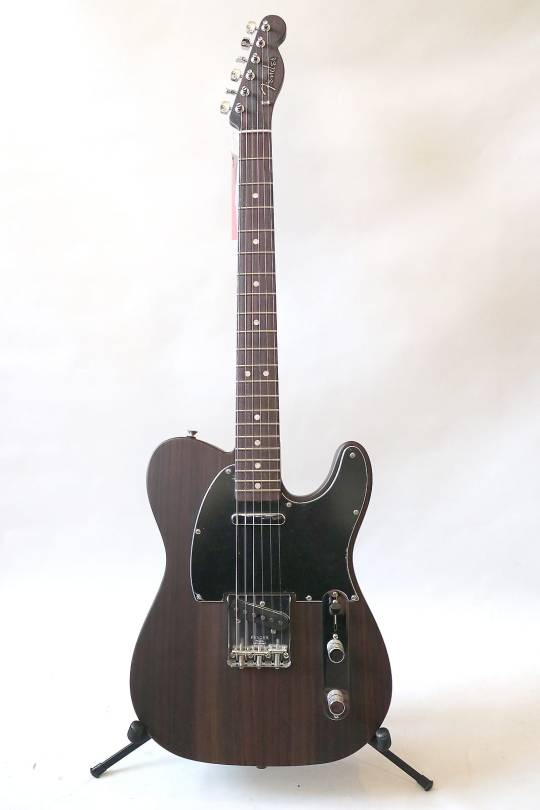
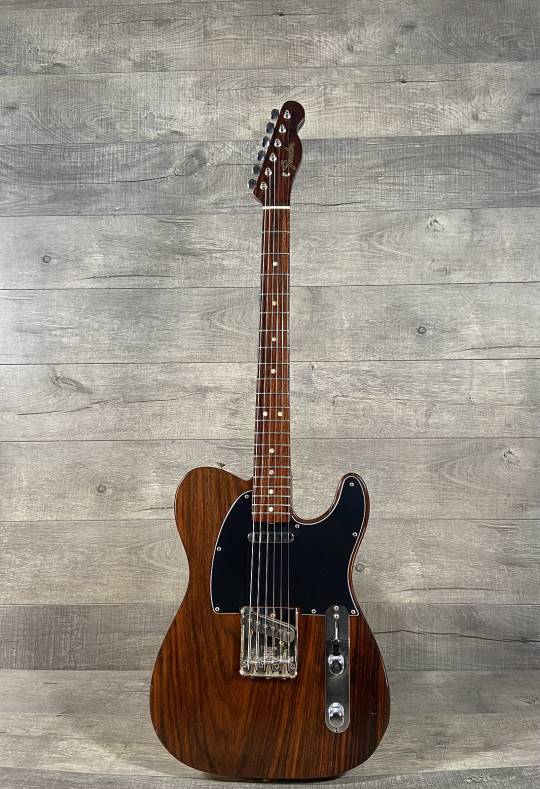
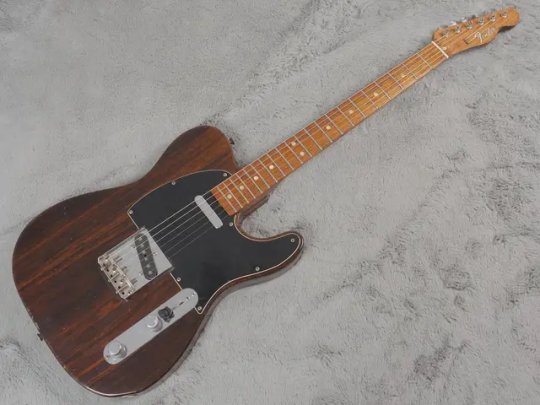
Anyway, now we're past that, let's go back to that personal favourite of mine, the Telecaster Thinline (hey, that rhymed!) The Tele Thinline is a much easier unit to understand in comparison to the Rosewood guitars you see above. It's also really interesting. To start with, it's really interesting to find that, as per usual, these were made in exactly the opposite way that you think. They didn't make these by taking some off the top, routing out the body, then gluing a top on.
They made this by scaling up Rossmeisl's original method: routing out sections both sides from the back, then gluing a "thin" sheet onto the back. If you know where to look, you can see the depth at which the back was removed, and where the new sheet rests, as with this example, courtesy of GuitarPoint... is what I would say if I had any more space to put images.
Alas, I appear to have hit the Tumblr limit, and how lucky am I that I had enough space for the quartet of rosewood models! As always with these things, it's a minor inconvenience, but I have a backup solution: hyperlinks! Here's the image, in hyperlink form. This is how I'll be showing things off from this point on.
Now, where was I... Ah, yes! The Telecaster Thinline is the first semi-hollow offering Fender ever made. But considering that "semi-hollow" usually means "big-bodied guitar with a centre block and two cavities on either side with as many f-holes". The exception here is precisely the guitar we're talking about: Fender were the first guitar company to do something like this, and considering how it's a model that still sees some popularity, I'd say it's going pretty well.
So, we're finally moving on to the '70s, starting with 1970, because of course, where we get the introduction of Rossmeisl's fifth and sixth guitars for Fender: the Montego, and the Hand Carved Ltd., both of which are more traditional jazz guitars than the Coronado or Jazzmaster. As one could reasonably expect of such a guitar from Fender, it quite solidly crashed and burned. They're some of the few guitars that Fender has never reissued, and I mean never reissued, these were only produced in the '70s, and in small number, because they never took off.
Also in 1970, the Fretless Precision bass. Quite an ironic name, no? The P-Bass was so named due to the frets, so going back to fretless seems like a bit of a step back, even if it's better than people tearing the frets out themselves and fucking up the fretboard in the process.
But anyway, we move to 1971. Remember how a few paragraphs ago I mentioned the head-adjust truss rod? Yeah, that comes into effect here. This is what's referred to as the "bullet" truss rod, so named for the adjustment screw looking like the "slug" of a bullet (for those unsure what I mean, bullets come in two main parts - the slug, and the casing). To avoid confusing myself on the matter further, I'm going to move onto my favourite part of this era of Fender design: the Wide Range humbucker.
The Wide Range was designed for Fender in or around 1971 by one Seth Lover. Yes, that Seth Lover, the one who designed the PAF for Gibson in 1954/55. Unlike the PAF, though, the Wide Range was constructed in such a way that resulted in them being tonally closer to Fender's single coils than Gibson's humbuckers, due to being built with the easier-to-machine CuNiFe magnetic alloy as opposed to the usual AlNiCo alloy, which is harder to machine into screw-type pole pieces. The downside to using CuNiFe over AlNiCo is that, by comparison, AlNiCo is "hotter" than CuNiFe, meaning that to compensate for the lower output, more winds had to be added into the construction, which resulted in a larger pickup and a need for a larger casing.
...that's the largest paragraph I've written, I'm sure. Then again, I did do some heavy rambling earlier on in the post, so I could be wrong. Now, where was I. Oh yes! The interesting thing is that the Wide Range was implemented into 4 models, all of which ceased production after 1979, and the original Wide Range design ceased produciton in 1979 as well, with reissues made in later years being made with either ceramic magnets or AlNiCo instead of CuNiFe. At least, until 2020, when Fender reintroduced CuNiFe Wide Range humbuckers. So, all of you with MIM or MIJ guitars with Wide Range humbuckers in them, know that they're normal humbuckers shoved in a Wide Range casing using wax to hold them in place.
Really, you'd never be able to get the high end of a '70s Wide Range-equipped guitar out of a modern reissue because of the electronics, being that the ones with a Wide Range in use were wired up with a 1MΩ potentiometer instead of the reissue standard 250KΩ potentiometer, likely supplied by Chicago Telephone Supply, the company that was, and still is, the usual supplier for electric potentiometers for all the top-tier guitar brands. Yes, this does mean that when "US electronics" is advertised as a feature of the guitar, it means that the main controls for the electronics are US-made.
Regardless of who supplied the damn pots, because that's of no concern here, why is 250K so much of an issue in comparison to 1M? Well, let's do a small tangent into resistance values used by guitars. According to Seymour Duncan (one of the biggest aftermarket pickup manufacturers out there, on par with Bartolini, DiMarzio and EMG), there's 5 common potentiometer ratings, with each having different uses depending on the pickup, those ratings being 25K, 100K, 250K, 500K and 1M. A potentiometer, as you probably already know, or could probably already guess, especially if you've worked with or have modded guitars before, is a variable resistor that changes the signal at the output depending on the setting of each pot on the guitar. For example, a 1972 Telecaster equipped with Wide Range humbuckers, which narrows it down to a '70s-style Thinline, would have been wired up using two 1 megaohm potentiometers, which allow for a more open and brighter top end and sound, due to the higher resistance values in both the volume and tone pot. With these pot, it would have likely been wired with .017 or .022μF capacitors, to counterbalance the harsh, biting, treble-y high end.
If you couldn't guess, guitar wiring is so very complicated. Alas, I do stuff with it anyway, so oh well!
Anyway, as the Wide Range took up the entire year in this explanation (yes, that's the excuse I'm using), let's move to 1972, where the Wide Range was actually put into use, and some patents were granted, such as this one - the B-Bender, for which more information can be found here. Fender didn't invent it, that accolade goes to Gene Parsons and Clarence White of Nashville West and the Byrds respectively, but Fender modified the device's design in order to simplify the mass production of it, and then made a prototype of that design as a proof of concept. However, as he was merely the consultant at Fender at this time, the most he could do was suggest that such a design be put into place, and nothing further.
As a result (which you could probably guess, considering it's CBS), the model was never put into full production, and that's as far as we go with the B-Bender. It did get licensed out to a different company, but it's really niche as a concept - I mean, why would you use a guitar that had a mechanism dedicated to raising the pitch of one string out of six, and it's controlled by pulling on the strap button of all things!
Look, I get you can't just modify the bridge construction to add something like the Hipshot Xtender or the D Tuna (yes, that's how you spell it), but carving out tons of body wood and using the strap button??? Why?! Was it so hard to add a mechanism or something that didn't get rid of valuable tonewood?
With that grievance out of the way, let's see what else happened for Fender in 1972. He was a silent partner for Music Man the previous year, or as it was originally known, Tri-Sonix (yes, with an X - Xtreme Kool Letterz in effect in an alternate use to normal). There's another Rhodes patent, this one in relevance to a "tone generator", something of which I have no clue about. Let's check 1973.
...all I'm seeing is the Tele Deluxe. The Thinline and Custom came out in 1972, but the Deluxe got sent to '73 presumably because of it being a radical departure from the usual Tele design. I mean, a Telecaster with a large headstock? No way they thought that would go down well, not least because it's kinda antithetical to how the headstocks are siloed nowadays. But that's not all. The Tele Deluxe also, in my opinion, inspired Norlin-era Gibson to do something with the Les Paul shape a few years later, in 1980 to be specific. Ever heard of the Gibson Sonex? If not, look it up. Once you've done that, look up a photo of a '73 Tele Deluxe, and then try to convince me that pickguard was not directly copied or at least wasn't a heavy inspiration for them.
Moving on, 1974. Yes, I'm skipping to 1974. The last patent I could make head or tail of was the B-Bender, the last 10 of 59 are just specific design elements being patented in different countries like Canada, Japan or Germany. I'm pretty sure I'm just running through the motions slowly at this point, at least until I can move onto the next few companies.
I guess this is what Leo must have felt like.
Anyway, '74 is when Leo finally gave Music Man that specific name, after changing it from Tri-Sonix to Musitek. Like I said, Xtreme Kool Letterz. '74 was also the 20th anniversary of the Strat, and nothing was done to celebrate that. '79 Strats did celebrate the 25th anniversary though, and the '80-'83 "The Strat" did massive things with it such as 100-micron gold plating. ONE HUNDRED. MICRONS. That is 0.1mm of gold, or about the thickness/diameter of the average strand of human hair. On EVERYTHING that was remotely made of metal, including the scratchplate screws. The FTC only needs 0.381-0.5 microns for something to be gold-plated, and CBS went "fuck it, go big or go home" and did 100. I'm pretty sure they actually lost money making those things.
Anyway, 1975 now, though I did deviate slightly to talk about the "The Strat" models. Yes, it's called "The Strat", like how Norlin made the Gibson The Les Paul from '76 to '79 (technically '80, but I don't know if they actually get counted). The difference is that it's so much easier to find information on the The Strat than it is for the The Les Paul. Guess that's what good documentation does for this sorta thing. Back on topic, Fender's non-compete clause is up, and we're steamrolling into Music Man. And I mean steamrolling, Fender was named the president of Music Man basically as soon as his non-compete expired.
And, by 1976, the other important company was started: CLF Research. This was Fender's way of mass-producing bodies and necks for sale by whichever company. Interestingly enough, this means that CLF Research acted a lot like Schecter did originally; they were both even founded in the same year, in the same state of the US. By June, guitar production had started up, and by August, basses followed suit, the instruments themselves being jointly designed by Fender, and one of the founders, Forrest White.
The instruments themselves first showed up in the 1976 catalog, being a 2-pickup guitar known as the StingRay 1, and the other being a 1-humbucker bass - the StingRay bass. Two things were unique about the bass, which I'm focusing on purely because I know far more about the bass rather than the guitar, those being that it was the original active electronics production bass. Seriously. Even with those 8 massive-ass pole pieces in the pickup, it was an active bass. The other, far less interesting, unique thing about the bass is the tuning configuration: 3+1.
"Wait, 3+1? The fuck does that mean?" Well, I'll tell you. It means 3 on the top, and 1 on the bottom, reportedly to eliminate "dead spots", which, let me tell you now, that is fucking bullshit. Dead spots on a neck don't come from the tuners, they come from the frets. Changing up the way the tuners are positioned does jack shit to improve or hurt "dead spots". But anyway, back to the active electronics, the preamp was mainly designed by the other founder, Tom Walker. The pre-amp is why there's 4 knobs on the control plate: 2 are your volume and tone, and the other two control the 2-band fixed-frequency EQ.
Meanwhile, back at Fender, the last model from the original company that I'll mention, the Starcaster. The Starcaster is... interesting. It's Fender's ES-335, as you could probably guess, and I could be mistaken, but I'm pretty sure it's the first 22-fret, 25.5" scale neck that Fender (the company) ever made. It's got 2 Wide Range humbuckers wired up to 1Meg pots (you remember that tangent from a few paragraphs ago?) with individual volume and tone pots. There's also a master volume pot. Just because. That's the one thing that reissues don't get right, other than the bridge being a 6-saddle string-through hardtail thing rather than a Tune-O-Matic and stopbar tailpiece. Makes me wonder if anyone's ever installed a Bigsby on one of those things.
Anyway, back to Music Man, and mostly leaving the Fender company alone altogether, '76-'79 was mostly uneventful for Fender, but there was a bit of an issue that slowly got worse as that period went on. You see, CLF and Music Man were treated as entirely different companies, and thus were controlled by the company's respective founders. Fender made the instruments, and then shipped them to Music Man for inspection and testing, while Music Man made their amplifiers and accessories in house. This is where that issue I mentioned comes in - every time there was a flaw or defect in the finish of a body or a neck, the guitar was shipped back to CLF for refinishing, and payment would be withheld until the finish was deemed good enough. Not so bad on paper, and, if anything, it's a good arrangement.
Except no it isn't! Due to "fibers" in the finish, a high percentage of instruments were sent back for refinishing. Now, that would be bad enough on its own; a large batch of guitars rejected for finish blemishes can at least be sold as a factory second or B-stock, but in this case, because Fender had no actual control over the Music Man brand name, he couldn't actually sell them, so the refinishing had to be done. Again, this would be fine, except the payment was withheld until the finish quality was deemed "acceptable", which is vague up the wall. If anything, "acceptable" is open to large variances in interpretation, and is thusly unreliable. As you could probably guess by now, this opened up a rift between Fender and Music Man.
This rift culminated in an all-out no-holds-barred office fist fight between Walker and Fender over who was at fault, after it was discovered that a whole batch of guitars had defective necks with truss rods that were installed in the inverse position. Considering they had head-adjust truss rods, this likely means that they were installed as a heel-adjust truss rod would be. Not exactly an easy fix.
As a result of this rift, ties were cut between Music Man and Fender in November of 1979. Fender, as a result, started his fourth company, G&L, with old buddies George Fullerton and Dale Hyatt, making guitars that were much like the old designs he came up with. But instead of doing new guitars exactly the same as the old guitars, his passion for innovation never ceased, and so he constantly aimed to make his guitars better than before.
There's a lot of ways he further innovated on his previous designs. Remember the Electric XII's split-coil pickups? Fender modified the design of those, and turned them into one integrated unit, which he then used on the Comanche model, the unique version of G&L's Strat. I'm not calling it a copy, because can you really call something a copy if it's by the same guy who came up with the original?
In general, though, G&L was partially Leo's excuse to just innovate further, allowing him to do or rectify things that he felt could be done better in one way or another, which can be best seen through the sheer amount of weird and/or interesting things he did with the hardware of the guitars. This includes the:
Magnetic Field Design (MFD) pickups, which are a ceramic bar magnet, combined with individually adjustible pole pieces made of iron, allowing for the setting of each string's output level per pickup. The only other way I could think of this even remotely being replicable on a different guitar would be hexaphonic pickups. As in, pickups that have 6 different signal outputs.
Dual-Fulcrum Vibrato, basically the 2-point synch trem that Fender introduced in 1986, but also taking some inspiration from the Floyd Rose floating tremolo system, in that it allows for the pitch of a note or chord to be raised as well as lowered, rather than only being lowered like the synch trem. I prefer to think of it as the step between a synch trem and the Floyd Rose, in that it's not meant to be set up or used as a floating trem, but it can do both up and down motions.
PTB Tone System, stands for Passive Treble and Bass, gives you 2 master tone controls - one rolls off the treble, as you would expect for a tone control, but the other instead removes low-end frequencies, actually giving the player something approaching a 2-band EQ, like one would have on the StringRay basses. Pretty neat, right? I certainly think so.
Saddle-Lock Bridge, which allows the saddles to resonate like one solid mass by tightening one Allen screw in the side of the bridge, which presses the saddles together. It also makes the string spacing more consistent, and because the bridges used are set into the body slightly, combined with the string-through nature, there's an increased amount of sustain as well, which is admittedly a relic of the '80s, in terms of wants, but it's at least something!
So, Leo's allowed to run wild with ideas. Admittedly, I have no frame of reference for how popular G&L guitars are. I mean, they certainly seem popular, but that's only by the measure that G&L are still around, rather than bankrupt. Like I say, they make Fender-style guitars, which some would term copies, but I don't due to the logic stated above: how can the man who made these shapes copy them?
This is what Leo did for most of the last 11 years of his life. In 1979, his first wife Esther passed due to cancer, and he remarried in 1980, marrying his second wife, who took his last name, becoming Phyllis Fender. She was actually named an honorary chairman of G&L after marrying Leo. Unfortunately, she also became his widow in 1991, after Leo passed due to complications with Parkinson's, which is the only thing that stopped him from working. Even after suffering a series of minor strokes, he continued to work.
But, nothing good ever lasts, and alas, neither did his life. His wife's did though, she only passed in 2020. But her late husband, that Leo Fender, and his buddies George and Dale, they sure had their own impacts. I'm sure there's an area of California where it's Fullerton Red and not Fiesta Red, but that's not important. Leo remained a household name in the guitar world for long after his death, winning a Technical Grammy Award in 2009, and the G&L USA guitars are, to this day, made in Fullerton, California, on the street named in his honour: Fender Avenue.
This took way too long to complete. I've been working on this on and off since December 3rd, at least, that's what the date stamp at the top of the draft says. Luckily, got it ready in time for Christmas. Consider it my gift to the guitar community. I hope you enjoyed, have a happy Christmas, Hanukkah, or whatever you celebrate, and were enlightened by this post. I'm pretty sure this entire post is just over 71k characters total, an achievement in and of itself for me, so if you didn't learn at least something from this, I'm impressed.
#takosader's ramblings number sqrt(121)#yeah that's right we doin math puns for this tag#x was a mad(wo)man#yep it's getting its own tag and everything#guitar#fender guitars#g&l guitars#fender esquire#telecaster#precision bass#fender stratocaster#fender jazzmaster#fender jazz bass#fender bass vi#fender jaguar#fender mustang#fender electric xii#fender coronado#fender starcaster#music man#sorry fnaf fans - wrong music man#stingray bass#no sense tagging any of the g&l guitars#it appears no tags exist for them#bit of a shame really#there's that many tagged guitars here#i'll probably attract the hordes with promises of strings amplification and a free set up#not that i could reasonably provide those over the interwebs#but oh well here we are#jeez this is a load of tags
1 note
·
View note
Video
youtube
9 out of 10 dentists recommend ESQUIRE | Opening Suite
1 note
·
View note
Text
instagram
Blackstrap Electrik Co - Green Despot
" No switch, circuit-mount volume so Zonk goes straight to in/out jacks. Like a Fender Esquire, this Zonk bypasses any extra stuff so you get direct injection. Hard biased for extreme performance: this one is ruder and crustier, with copious crackle and sputter in the decay. Thank the 381 for the over-the-top behavior. Tuned to work w/ mains power: no battery needed! Reclaimed military mini wedge. Cast aluminum. Indestructible. No stops inside. MKI-esque transistor compliment: 2G381(!), OC75, big G 2G374 for most extreme Zonk sounds. Rare chocolate '60s Vero; Piher volume trim and resistors; AB early resistors; correct RS and Mullard box caps; etc."
cred: instagram.com/blackstrap_electrik
12 notes
·
View notes
Text

David Gilmour and his 1955 Fender Esquire, 2015
6 notes
·
View notes
Text

... sound of rebellion ....
" I don't think I'm easy to talk about. I've got a very irregular head. And I'm not anything that you think I am anyway. "
Remembering Roger Keith Barrett
18 years without the legendary original Pink Floyd singer and guitarist Syd Barrett. He sadly left us back in 2006 at the age of 60.
Shine on you crazy diamond ...
#sound of rebellion#syd barrett#famous guitars#fender#fender guitars#fender esquire#mirrored 1962 fender esquire#shine on you crazy diamond#live music#music matters#Spotify
14 notes
·
View notes
Text
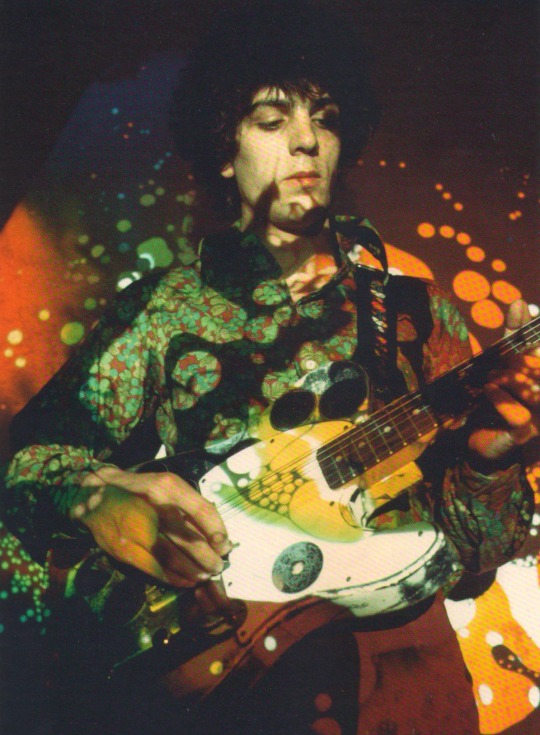
Syd Barrett’s “Mirror Disc” Telecaster guitar is the instrument with which he is most widely associated, even though it isn't actually a Telecaster at all; it is in fact a Fender Esquire '62. Barrett purchased the guitar in early 1965 and towards the end of 1966 customized it by sticking 15 polished metal discs on the front of the body, which reflected the blaze of Pink Floyd's early light-shows to great effect.
Syd Barrett used the guitar on all of his recorded work with Pink Floyd, but subsequently swapped it for a white 1964 Fender Telecaster. He later regretted doing this, stating that the Esquire had always been his favourite instrument. Unfortunately, the whereabouts of the original is unknown and a reproduction had to be made for the Pink Floyd exhibition, Their Mortal Remains.
Syd Barrett performs with the Telecaster in Hampstead, June 1967 | Photo by Andrew Whittuck
credit | Glenn Povey
129 notes
·
View notes
Text

David Gilmour And his Fender Esquire. 🎧
77 notes
·
View notes
Text

Jeff Beck's Fender Esquire
11 notes
·
View notes


